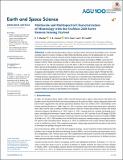Files in this item
Multiscale and multispectral characterization of mineralogy with the ExoMars 2020 rover remote sensing payload
Item metadata
| dc.contributor.author | Allender, E. J. | |
| dc.contributor.author | Cousins, C. R. | |
| dc.contributor.author | Gunn, M.D. | |
| dc.contributor.author | Caudill, C.M. | |
| dc.date.accessioned | 2020-04-23T15:30:05Z | |
| dc.date.available | 2020-04-23T15:30:05Z | |
| dc.date.issued | 2020-04-22 | |
| dc.identifier | 266317762 | |
| dc.identifier | fcbd7fdf-122e-4486-9a73-296e1d5fb420 | |
| dc.identifier | 85083791938 | |
| dc.identifier | 000534600100005 | |
| dc.identifier.citation | Allender , E J , Cousins , C R , Gunn , M D & Caudill , C M 2020 , ' Multiscale and multispectral characterization of mineralogy with the ExoMars 2020 rover remote sensing payload ' , Earth and Space Science , vol. 7 , no. 4 , e2019EA000692 . https://doi.org/10.1029/2019EA000692 | en |
| dc.identifier.issn | 2333-5084 | |
| dc.identifier.other | RIS: urn:996A2DE41A8C5B1EB1F9CE1373B2E2BD | |
| dc.identifier.other | ORCID: /0000-0002-3954-8079/work/72842707 | |
| dc.identifier.other | ORCID: /0000-0002-0052-7895/work/72842865 | |
| dc.identifier.uri | https://hdl.handle.net/10023/19849 | |
| dc.description | This work was supported by the UK Space Agency (ST/P001297/1 and ST/P001394/1). Cousins also acknowledges the Royal Society of Edinburgh for funding. | en |
| dc.description.abstract | In 2020, the European Space Agency and Roscosmos will launch the ExoMars rover, with the scientific objective to detect evidence of life within the martian surface via the deployment of a 2 meter drill. The ExoMars Pasteur payload contains several imaging and spectroscopic instruments key to this objective: the Panoramic Camera (PanCam), Infrared Spectrometer for ExoMars (ISEM), and Close‐UP Imager (CLUPI). These instruments are able to collect data at a variety of spatial (sub‐mm to decimeter) and spectral (3.3 to 120 nm) resolutions across the 440 to 3300 nm wavelength range and collectively will form a picture of the geological and morphological characteristics of the surface terrain surrounding the rover. We deployed emulators of this instrument suite at terrestrial analog sites that formed in a range of aqueous environments to test their ability to detect and characterize science targets. We find that the emulator suite is able to effectively detect, characterize, and refine the compositions of multiple targets at working distances spanning from 2‐18 m. We report on: (i) the detection of hydrothermal alteration minerals including Fe‐smectites and gypsum from basaltic substrates, (ii) the detection of late‐stage diagenetic gypsum veins embedded in exposures of sedimentary mudstone, (iii) multispectral evidence of compositional differences detected from fossiliferous mudstones, and (iv) approaches to cross‐referencing multi‐scale and multi‐resolution data. These findings aid in the development of data products and analysis toolkits in advance of the ExoMars rover mission. | |
| dc.format.extent | 18 | |
| dc.format.extent | 76266262 | |
| dc.language.iso | eng | |
| dc.relation.ispartof | Earth and Space Science | en |
| dc.subject | Remote sensing | en |
| dc.subject | ExoMars | en |
| dc.subject | Mineralogy | en |
| dc.subject | XRD | en |
| dc.subject | Spectroscopy | en |
| dc.subject | Mars | en |
| dc.subject | GE Environmental Sciences | en |
| dc.subject | QC Physics | en |
| dc.subject | DAS | en |
| dc.subject.lcc | GE | en |
| dc.subject.lcc | QC | en |
| dc.title | Multiscale and multispectral characterization of mineralogy with the ExoMars 2020 rover remote sensing payload | en |
| dc.type | Journal article | en |
| dc.contributor.sponsor | Science & Technology Facilities Council | en |
| dc.contributor.sponsor | The Royal Society of Edinburgh | en |
| dc.contributor.institution | University of St Andrews. St Andrews Centre for Exoplanet Science | en |
| dc.contributor.institution | University of St Andrews. School of Earth & Environmental Sciences | en |
| dc.identifier.doi | https://doi.org/10.1029/2019EA000692 | |
| dc.description.status | Peer reviewed | en |
| dc.date.embargoedUntil | 2020-04-22 | |
| dc.identifier.grantnumber | ST/P001297/1 | en |
| dc.identifier.grantnumber | en |
This item appears in the following Collection(s)
Items in the St Andrews Research Repository are protected by copyright, with all rights reserved, unless otherwise indicated.

